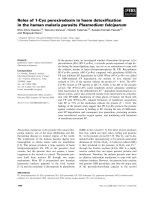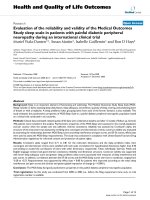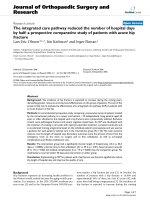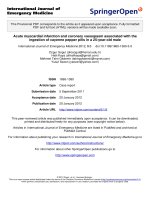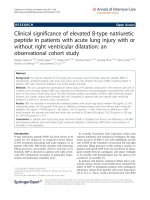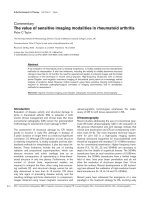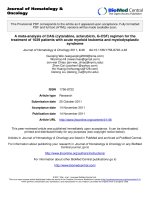Value of the clinical syntax score for prediction of 1 year mortality in patients with acute myocardial infarction undergoing percutaneous coronary intervention
Bạn đang xem bản rút gọn của tài liệu. Xem và tải ngay bản đầy đủ của tài liệu tại đây (1.39 MB, 8 trang )
Journal of military pharmaco-medicine no4-2019
VALUE OF THE CLINICAL SYNTAX SCORE FOR
PREDICTION OF 1-YEAR MORTALITY IN PATIENTS WITH
ACUTE MYOCARDIAL INFARCTION UNDERGOING
PERCUTANEOUS CORONARY INTERVENTION
Nguyen Quang Toan1; Pham Manh Hung2; Nguyen Oanh Oanh3
SUMMARY
Objectives: To study the prediction value of clinical SYNTAX score in patients with acute
myocardial infarction undergoing percutaneous coronary intervention in 30 days and one year.
Subjects and methods: 579 patients with acute myocardial infarction, of whom 296 patients
were followed from 30 days to 1-year. Mortality and major cardiovascular events after 30-day
and 1-year and clinical SYNTAX score were analysed. Results: The patients were divided into
three groups according to the clinical SYNTAX score: clinical SYNTAX score 1 (clinical
SYNTAX score 1) < 22.95 (115 patients), mean clinical SYNTAX score (clinical SYNTAX score
2) from 22.95 to less than 35.95 (74 patients), high clinical SYNTAX score (clinical SYNTAX
score 3) ≥ 35.95 (107 patients). The highest survival rates in the low-scoring group after 30 days
and after 1-year was 95.7% and 93.0% compared with 93.2% and 85.1% in the clinical
SYNTAX score mid group compared to 79.4% and 73.8% in the clinical SYNTAX score high
group, the difference was significant with p < 0.001. The incidence of major cardiovascular
events was low in the low-scoring group after 30 days and 1-year (94.6% and 88.7%) compared
with the clinical SYNTAX score mid group (93.0% and 91.9%) and the clinical SYNTAX score
high group (87.9% and 86.0%), with p (log-rank) = 0.164 and p (log-rank) = 0.445. Conclusion:
Clinical SYNTAX score was useful in predicting mortality in patients with acute myocardial
infarction undergoing percutaneous coronary intervention in short and long-term.
* Keywords: Acute myocardial infarction; Clinical SYNTAX score; Percutaneous coronary intervention.
INTRODUCTION
Cardiovascular disease is the most
common cause of death in the world. The
global burden study 2013 (GBD) estimated
that cardiovascular disease caused 17.3
million deaths, accounting for 31.5% of
total deaths and 45% of total deaths due
to non-communicable diseases and resulted
in premature death to more than 1.4 million
people before 75 years old in Europe [1].
The new definition of the World Health
Organization (WHO), myocardial infarction
is the increase and/or decrease of myocardial
biomarkers upper 99% of its limit and at
least one of the characteristics; typical
chest pain, electrocardiographic changes,
regional movement disorders detected by
imaging diagnostic measures or evidence
of thrombosis in coronary artery [1]. It is
the leading cause of death and also a
major cause of the burden of disease in
developing countries.
1. Thainguyen General Hospital
2. Vietnam National Heart Center
3. 103 Military Hospital
Corresponding author: Nguyen Quang Toan ()
Date received: 25/01/2019
Date accepted: 09/04/2019
106
Journal of military pharmaco-medicine no4-2019
Saving lives of acute myocardial patients
is an immediate task of clinicians but is
not enough, we need to predict the risk of
cardiovascular for patients after the
intervention. There are many parameters
and transcripts to help clinicians predict
patients with myocardial infarction under
intervention such as: Leamen score,
Zwolle, MAYO, PAMI, CADILLAC, GRACE,
ACEF, Gensini. However, these scales
have many limitations, so far they have
not been widely applied in clinical practice
for these patients.
The SYNTAX score (CSS) was born in
2005, inheriting and developing previous
scores. CSS incorporate additional clinical
factors that can predict major cardiovascular
events under percutaneous coronary
intervention during short and long term
periods [3]. Therefore, we conducted this
study aiming: To study the prognostic
value after 1 year of CSS in patients with
acute myocardial infarction undergoing
percutaneous coronary intervention.
SUBJECTS AND METHODS
1. Subjects.
579 patients with acute myocardial
infarction received percutaneous intervention
at Vietnam National Heart Center and
103 Military Hospital, from May 2015 to
February 2018. 296 patients were followed
after intervention from 30 days to 12
months, there were 7 critically ill patients
after the intervention and death.
* Selection criteria:
All patients with acute myocardial
infarction received percutaneous coronary
intervention at Vietnam National Heart
Center and 103 Military Hospital from
January 2015 to February 2018.
* Diagnostic criteria for myocardial
infarction according to the 3rd consensus
definition of WHO/ESC/AHA/ACC in 2012:
* Exclusion criteria: Contraindications
to use of antiplatelet agents such as aspirine,
clopidogrel, contrast, hepatic, renal failure...
and patients did not agree to participate.
2. Methods.
* Study content:
- Study design: Follow-up with comparative
analysis.
- SYNTAX score by software SYNTAX
score calculator 2.11.
- Calculate CSS:
The formula: CSS = SS x (AGE/EF)
+ 1 (for each drop of creatinine
10 mL/minute with creatinine clearance
< 60 mL/minute/1.73 m2).
- Major cardiovascular events: All-cause
mortality, target vessel myocardial infarction,
stroke, target vessel revascularization.
* Data:
Information collected from the research
record will be processed according to the
medical statistical algorithms of Epi.Data
and SPSS 21.0 software.
For comparison, we used the algorithm
"t-test", test 2, odds ratio (odds ratio),
logistic regression algorithm, log-rank test...
Results are considered statistically
significant with p < 0.05.
RESULTS
Calculating the cut-off point of the CSS,
we divided the patients into three groups
of high, medium and low score as follows:
CSS is low (CSS1) < 22.95 (115 patients),
middle CSS (CSS2): 22.95 - < 35.95
(74 patients), high CSS score (CSS3)
≥ 35.95 (107 patients).
107
Journal of military pharmaco-medicine no4-2019
Table 1: General characteristics of patients study.
Characteristics
Male
Average age
X SD or n (%)
450 (77.7%)
65.55 ± 10.89
History of hypertension
301 (52%)
History of diabetes
77 (13.3%)
Heart rate
80.15 ± 17.59
Systolic blood pressure (mmHg)
123.68 ± 23.32
Diastolic blood pressure (mmHg)
75.68 ± 14.26
Killip ≥ 2
86 (14.9%)
Creatinine
95.62 ± 27.64
EF < 40%
96 (16.6%)
Door-to-ballon time (minutes)
816.22 ± 1501.12
DES (drug-coated stent)
555 (95.9%)
TIMI 3 before intervention
93 (16.1%)
TIMI 3 after intervention
566 (97.8%)
One vessel disease
202 (34.9%)
Two vessel disease
217( 37.5%)
Three vessel disease
160 (27.6%)
≥ 1 bifurcation
181 (31.3%)
≥ 1 trifurcation
6 (1.0%)
≥ 1 occlusion
338 (67.0%)
≥ 1 tortuous lesion
32 (5.5%)
≥ 1 lesion ≥ 20 mm
258 (44.6%)
≥ 1 calcified lesion
65 (11.2%)
≥ 1 lesion with thrombus
406 (70.1%)
≥ 1 ostial lesion
53 (9.2%)
The male patient was 3 times higher than females. Patients with a history of
hypertension made up the highest rate (52.0%). One vessel disease accounted for
34.9%, less common than multi vessel disease. Patients received drug-coated stent
occupied 95.9% and the rate of coronary artery flow after intervention improved very
well with TIMI 3 at 97.8%.
108
Journal of military pharmaco-medicine no4-2019
Figure1: Distribution of CSS.
The number of patients with CSS was around 25. The lowest was the group of
patients with scores between 75 - 100 points. The average CSS was 30.28 ± 18.84.
Table 2: Relationship between CSS and death.
CSS1
CSS2
CSS3
n (%)
n (%)
n (%)
After 30 days
5 (4.3%)
5 (6.8%)
22 (20.6%)
< 0.001
After 180 days
5 (4.3%)
8 (10.8%)
24 (22.4%)
< 0.001
12 months
8 (7.0%)
11 (14.9%)
28 (26.2%)
< 0.001
Death
p
30 days after intervention, mortarity in the CSS3 group was the highest (20.6%)
compared to groups CSS2 and CSS1 (6.8% and 4.3%), respectively, p < 0.001, which
was statistically significant. The results were similar after intervention for 180 days and
12 months.
Table 3: Relevant linear regression analysis between CSS groups and death.
Time
HR
1,2
(95%CI)
p
HR
1,3
(95%CI)
3,2
p
HR
(95%CI)
p
30 days
1.57 (0.45 - 5.41)
0.478
5.12 (1.94 - 13.53)
0.001
0.31 (0.12 - 0.81)
0.017
180 days
2.51 (0.82 - 7.69)
0.106
5.69 (2.17 - 14.94)
< 0.001
0.44 (0.198 - 0.98)
0.045
12 months
2.19 (0.88 - 5.44)
0.092
4.23 (1.94 - 9.36)
< 0.001
0.51 (0.26 - 1.03)
0.061
After 30 days, mortality in the CSS3 group was 5.12 times higher than CSS1 group,
the difference was significant (p < 0.05) and (HR = 5.12 and 95%CI from 1.94 to 13.53,
p = 0.001). After 12 months, the mortality rate of CSS3 group was 4.23 times higher
than CSS1 group, the difference was significant (p < 0.05) and (HR = 4.23 and 95%CI
from 1.94 to 9.36 with p < 0.001).
109
Journal of military pharmaco-medicine no4-2019
Figure 2: Kaplan-Meier survival after 30 days and 1 year.
High CSS (CSS3) had the lowest survival rate of 79.4%, middle CSS group (CSS2)
and low CSS1 had the corresponding rate of 93.2% and 95.7%, respectively with
p (Log-rank) < 0.001), with statistical significance. Similarly, the survival rate after
12 months of the three groups was also significantly different with p (Log-rank) < 0.001.
Table 4: Relationship between CSS and events.
CSS1
CSS2
CSS3
n (%)
n (%)
n (%)
After 30 days
8 (7.0%)
4 (5.4%)
13 (12.1%)
0.211
After 180 days
11 (9.6%)
6 (8.1%)
13 (12.1%)
0.653
12 months
13 (11.3%)
6 (8.1%)
15 (14.0%)
0.470
Major cardiovascular
events
p
It can be seen that after 30 days, 180 days, 12 months of intervention, the CSS3
group had the highest rate of occurrence of mortality and major cardiovascular events
being 12.1%; 12.1% and 14.0% compared to CSS2 group with the rates of 5.4%, 8.1%
and 8.1%, respectively and 7.0%, 9.6%, 11.3%, respectively in CSS1 group. However,
this difference was not significant with p > 0.05.
Figure 3: Kaplan-Meier without major cardiovascular events
after 30 days and 1 year.
110
Journal of military pharmaco-medicine no4-2019
Kaplan-Meier of CSS3 group (red line)
had no lowest event rate of 87.9%
compared with the remaining two clinical
SYNTAX groups p (Log-rank) > 0.05. In
other words, the major cardiovascular
events rate of the CSS3 group was the
highest. Similar to the results after 12
months, we also found that the higher the
CSS score, the more likely the occurrence
rate of events. However, the difference
was not significant p > 0.05.
DISCUSSION
1. Relationship between CSS and
death.
From the results, we found that: there
were 32 patients who died after 30 days,
the highest death rate in the CSS3 group
was 22/107 patients (20.6%), compared
to two groups of middle score CSS2 (5/74
patients = 6.8%) and low score CSS1
(5/115 patients = 4.3%) with p < 0.001
statistically significant. The mortality in the
CSS3 group was 5.12 times higher than
CSS1 group, the difference was
significant (p < 0.05) and (HR = 5.12 and
95%CI from 1.94 to 13.53 with p = 0.001).
Similarly, after 12 months, the mortality
rate of CSS3 group was 4.23 times higher
than that of CSS1 group, the difference
was significant (p < 0.05) and (HR = 4.23
and 95%CI from 1.94 to 9.36, p < 0.001).
The Kaplan-Meier, we found that the high
CSS3 group had the lowest survival of
79.4% (red line) compared to the middle
CSS2 (93.2%) (yellow line) and low score
group CSS1 (95.7%) (blue line), the
difference was statistically significant with
p (Log-rank) < 0.001. These results were
similar after 12 months (table 2, table 3
and figure 2).
CSS is an independent prognostic
factor for the risk of death in patients with
acute myocardial infarction under coronary
artery intervention 30 days and 12 months.
Cetinkal G et al conducted a study on
433 patients who were diagnosed with
STEMI and underwent p-percutaneous
coronary intervention. CSS was calculated
by multiplying the anatomically derived
SYNTAX score (Sx) by the modified age,
creatinine, and ejection fraction score.
Patients were divided into tertiles
according to the CSS: CSS (low) ≤ 14
(141 patients), 14 < CSS (mid) ≤ 26
(144 patients) and CSS (high) > 26
(148 patients). The primary endpoints
were defined as all-cause mortality,
myocardial infarction, and cerebrovascular
events over 15 months' follow-up. Primary
endpoints achieved in 9.2% of patients
with CSS ≤ 14, 12.5% of them had
14 < CSS ≤ 26 and 28.4% of them had
CSS > 26 (p < 0.001). Kaplan-Meier
analysis showed that the CSS > 26 group
had a significantly higher incidence of
primary endpoints [p (Log-rank) < 0,001].
CSS > 26 was identified as an independent
predictor for all-cause mortality, myocardial
infarction, and cerebrovascular events
(HR = 3.58, 95%CI from 1.68 to 7.60,
p = 0.001). Receiver operating characteristic
analysis found areas under the curve of
0.66, 0.59, and 0.64 for CSS, Sx score
and age, creatinine and ejection fraction
score (p < 0.001, p = 0.01, p < 0.001,
respectively) [4].
From January 2013 to December
2013, He C et al carried out a study on
6,099 consecutive patients with ACS
admitted to FuWai Hospital and underwent
percutaneous coronary intervention.
111
Journal of military pharmaco-medicine no4-2019
Patients were divided into low CSS group
(CSS ≤ 6.5; 2,012 patients), mid-CSS
group (6.5 < CSS < 13.8; 2,056 patients)
and high CSS group (CSS ≥ 13.8; 2.031
patients). At 2-year follow-up, rates of
cardiac death and major adverse cardiac
events were significantly higher in high
CSS group. Compared with baseline
SS, CSS demonstrated a significant
improvement in performance for 2-year
cardiac
death
(receiver-operating
characteristic curve C-statistics: 0.74 vs.
0.62, p < 0.001) but not for and major
cardiovascular events (receiver-operating
characteristic curve C-statistics: 0.60 vs.
0.59, p = 0.29) [5].
2. Relationship between CSS and
and major cardiovascular events.
After 30 days, the rate of major
cardiovascular events in the high score
group CSS3 was the highest (12.1%)
compared to the average group of CSS2
scores (5.4%) and the low score group
CSS1 (7.0%), with p = 0.211. When
analyzing the Kaplan-Meier, we found that
the high score group CSS3 without events
was the lowest (87.9%) (red line)
compared to the average group of CSS2
score of 94.6% (yellow line) and low score
CSS1 (93.0%) (blue line), the difference
was not statistically significant with p
(Log-rank) = 0.164. At 12 months, we
found that the occurrence rate of highpoint group CSS3 was the highest
(14.0%) compared to the group of CSS2
(8.1%) and the low score group CSS1
(11.3%). However, the difference was not
statistically significant (with p > 0.05).
Kaplan-Meier after 1-year, we found that
the high score group CSS3 without events
was the lowest (86.0%) (red line)
112
compared to the average group of CSS2
(91.9%) (yellow line) and the low score
group CSS1 (88.7%) (blue line), the
difference was not statistically significant
with p (Log-rank) = 0.445 (table 4 and
figure 3).
Pyxaras SA, ACEF and CSS were
calculated in 221 consecutive patients
with stable angina undergoing rotastenting. Mean age of the patients was 74
± 10 years, left ventricular ejection
fraction was 61 ± 18% and final burr size
1.78 ± 0.24 mm, of which 2.6 ± 0.9 burrs
used for each patient. Primary end-point
was major cardiovascular events at oneyear defined as the composite of cardiac
death, myocardial infarction, and target
vessel revascularization. Post-hoc analysis
was performed by stratifying the clinical
outcome according to ACEF and CSS
tertiles. At 1 year, there was a significantly
higher major cardiovascular events rate in
the high tertile of ACEF (24% for ACEF
high vs. 13% for ACEF mid vs. 9% for
ACEF low; p = 0.017) and CSS (25% for
CSS high vs. 12% for CSS mid vs. 8% for
CSS low; p = 0.008). The predictive
accuracy for both ACEF and CSS was
moderate (c-statistics, 0.629 and 0.638,
respectively). Both ACEF and CSS can
predict with moderate accuracy and major
cardiovascular events at 1-year in
patients with heavily calcified coronary
stenosis undergoing rotational atherectomy
with stent implantation [6].
CONCLUSION
Clinical SYNTAX score is valuable in
prognosis of mortality for patients with
acute myocardial infarction after coronary
intervention during 30 days and 12 months.
Journal of military pharmaco-medicine no4-2019
REFERENCES
1. Nguyễn Lân Việt. Thực hành bệnh tim
mạch. Nhà xuất bản Y học. 2014.
2. Townsend N, Wilson L, Bhatnagar P et
al. Cardiovascular disease in Europe:
Epidemiological update 2016. Eur Heart J.
2016, 37 (42), pp.3232-3245.
3. Scherff F, Vassalli G, Surder D et al.
The SYNTAX score predicts early mortality
risk in the elderly with acute coronary
syndrome having primary PCI. J Invasive
Cardiol. 2011, 23 (12), pp.505-510.
4. Cetinkal G, Dogan S.M, Kocas C et al.
The value of the clinical SYNTAX score in
predicting long-term prognosis in patients with
ST-segment elevation myocardial infarction
who have undergone primary percutaneous
coronary intervention. Coron Artery Dis. 2016,
27 (2), pp.135-142.
5. He C, Song Y, Wang C.S et al.
Prognostic value of the clinical SYNTAX score
on 2-year outcomes in patients with acute
coronary
syndrome
who
underwent
percutaneous coronary intervention. Am J
Cardiol. 2017, 119 (10), pp.1493-1499.
6. Pyxaras S.A, Mangiacapra F, Wijns W
et al. ACEF and clinical SYNTAX score in the
risk stratification of patients with heavily
calcified coronary stenosis undergoing
rotational atherectomy with stent implantation.
Catheter Cardiovasc Interv. 2014, 83 (7),
pp.1067-1073.
113

